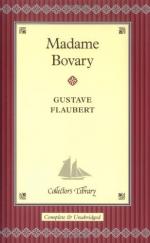|
This section contains 5,116 words (approx. 18 pages at 300 words per page) |

|
SOURCE: "Madame Bovary" in Flaubert Writing: A Study in Narrative Strategies, Stanford University Press, 1986, pp. 82-107.
In the following excerpt, Ginsburg examines how an analysis of Flaubert's early works contributes to an understanding of Madame Bovary. "Instead of beginning a new mode of narration, as most critics claim it does," Ginsburg argues, "Madame Bovary marks a return—with important modifications—. . . to the early works."
In the first version of the Tentation, the narrator and his surrogate Antoine disappeared—"died"—and gave their places to a spectacle that faced them as an independent reality. The citational character of the work, its rhetorical order, the conventional, cliché nature of the visions, the emphasis on the problem of incarnation—all contributed to making Antoine a passive and empty figure. In the person of Antoine, the self does not express its original, individual desires through language, but instead is seen as predetermined...
|
This section contains 5,116 words (approx. 18 pages at 300 words per page) |

|


